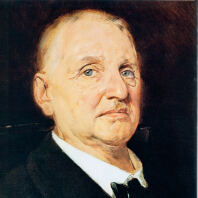Anton Bruckner
Composer
Along with Johannes Brahms, Anton Bruckner was the most important German-language symphonist in the second half of the 19th century. Both composers adhered to the classical, four-movement model of the symphony. The fact that Bruckner was a devout Catholic led his contemporaries to describe his monumental symphonies as “cathedrals” of sound. The music press also assigned him – unasked – to Richard Wagner’s progressive party, which was opposed to the conservative party associated with Brahms. In fact, Bruckner openly worshipped Wagner: his Third Symphony is dedicated to him, and the Adagio of the Seventh is considered funeral music for the, according to Bruckner, “most blessed, most beloved, immortal master”.
Born near Linz in 1824, Anton Bruckner was the son of a teacher – a profession he initially practised himself. Parallel to his work as a teacher in St Florian and as organist in Linz cathedral, he studied music theory. Bruckner continued his studies even after he had brilliantly passed his final exams, before he – late in life – entered the public eye as a composer: his nominal First Symphony was premiered when Bruckner was already 41 years old. From 1868 until his death, he lived in Vienna, where, however, he was long denied the recognition he deserved. Most of Bruckner’s nine numbered symphonies are available in several versions – the perfectionist composer sometimes worked on them for years. These versions offer an exciting insight into the work of an artist who had a decisive influence on the symphonic genre. His last, the unfinished, harmonically daring Ninth belongs to the prehistory of musical Modernism. While Hans von Bülow kept his distance from Bruckner even as chief conductor of the Berliner Philharmoniker, his successor Arthur Nikisch established his music with the orchestra.